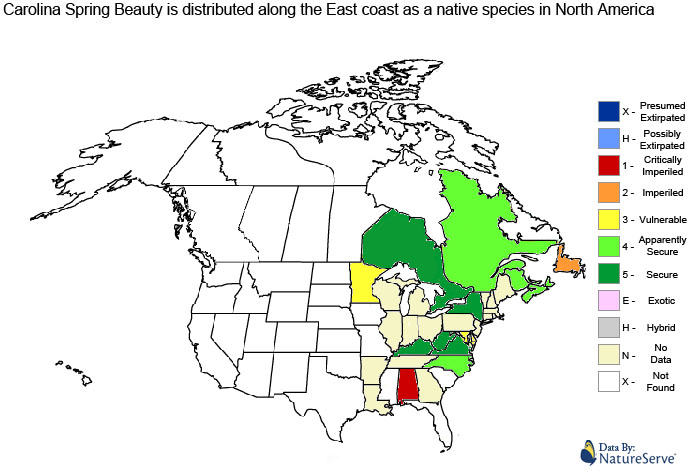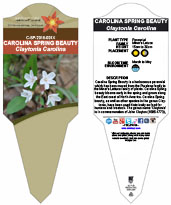

| Plant Name | Carolina Spring Beauty | |
| Scientific Name | Claytonia Carolina | |
| Family | Miners Lettuce (Formally Purslane) | |
| Plant Type | Perennial | |
| Start of Blooming Season | March | |
| End of Blooming Season | May |

| Soil Conditions | |
| Soil Moisture | |
| Sunlight | |
| Notes: |

Carolina Spring Beauty is a perennial plant growing from a globe shaped tuber that is 1cm to 2cm across. The leaves of the carolina spring beauty are linear basal shaped 3cm to 14cm long, 5mm to 13mm wide without stalks. The flowers of the carolina spring beauty are white with pink stripes 5mm to 12mm across. Each flower has five petals with two sepals 5mm to 7mm long. Each flower also contains 5 stamens and 1 pistil. The flowers are radially symmetrical and grow in clusters of two to ten with a nodding bract. Carolina Spring Beauty produces a fruit capsule which is globe shaped and enclosed by two persistent sepals with six seeds contained within.

| Plant Height | 15cm to 30cm |
| Habitat | Moist Woods, Thickets, Clearings, Lawns |
| Leaves | Linear basal leaves 5cm to 14cm long |
| Leaf Margin | Entire |
| Leaf Venation | Longitudinal |
| Stems | smooth stems |
| Flowering Season | March to May |
| Flower Type | Radially Symmetrical |
| Flower Colour | White |
| Pollination | Bees, Insects |
| Flower Gender | Flowers are hermaphrodite and the plants are self-fertile |
| Fruit | Hard oval seeds |
| USDA Zone | 3B (-34°C to -37°C) cold weather limit |

No known health risks have been associated with carolina spring beauty. However ingestion of naturally occurring plants without proper identification is not recommended.

 |
-Click here- or on the thumbnail image to see an artist rendering, from The United States Department of Agriculture, of carolina spring beauty. (This image will open in a new browser tab) |

Carolina Spring Beauty can be referenced in certain current and historical texts under the following three names:
Carolina Spring Beauty can be translated into the following select languages:
| Arabic | ربيع الجمال | Bulgarian | пролетта красота | Chinese (Sim) | 春美 |
| Croatian | proljeće ljepota | Czech | jaro krásal | Danish | foråret skønhed |
| Dutch | lente schoonheid | Esperanto | printempa beleco | Estonian | kevadel ilu |
| Finnish | kevät kauneus | French | printemps beauté | German | Frühjahr Schönheit |
| Greek | την άνοιξη ομορφιά | Hebrew | יופי האביב | Hungarian | tavaszi szépség |
| Italian | primavera di bellezza | Japanese | 春の美しさ | Korean | 봄의 아름다움 |
| Punjabi | ਬਸੰਤ ਸੁੰਦਰਤਾ | Lithuanian | pavasario grožis | Norwegian | våren skjønnhet |
| Persian | زیبایی بهار | Polish | Portuguese | primavera beleza | |
| Romanian | primăvară frumusete | Russian | весной красоты | Slovak | jar krása |
| Spanish | belleza de primavera | Swedish | fjäder skönhet | Tagalog | |
| Turkish | bahar güzelliği | Ukrainian | навесні краси | Vietnamese | mùa xuân đẹp |

| The information provided in this conservation assessment has been provided by the Natureserve Database in conjunction with various federal, provincial, state, county, district, regional, and municipal governments as well as public and private conservation authorities. Information in this section is accurate from the last time this article was updated. | |
 |
Carolina spring beauty is considered to be a secure native species in North America. |

 |

 |
The MIROFOSS database offers free printable garden tags for personal and non-profit use. These tags can be used to properly identify plant samples in a garden. Click on the tags shown on the the screen or -click here- to download a full size jpeg image for a carolina spring beauty identification tag; which can be printed on paper or used with a plastic laser printer. |
 |
What's this? What can I do with it? |

| Description | Davis, R. J. 1966. The North American perennial species of Claytonia. Brittonia 18:285-303 |
| Description | Fassett, N. 1976. Spring flora of Wisconsin. University of Wisconsin Press, Madison, Wisconsin. |
| Description | Gleason, H. A., and A. Cronquist. 1991. Manual of vascular plants of northeastern United States and adjacent Canada. Second Edition. New York Botanical Garden, Bronx, New York. |
| Folklore | MacKinnon, Kershaw, Arnason, Owen, Karst, Hamersley, Chambers. 2009. Edible & Medicinal Plants Of Canada ISBN 978-1-55105-572-5 |
| Image Rendering | USDA-NRCS PLANTS Database / USDA NRCS. Wetland flora: Field office illustrated guide to plant species. USDA Natural Resources Conservation Service. |
| Environment | National Audubon Society. Field Guide To Wildflowers (Eastern Region): Alfred A. Knopf. ISBN 0-375-40232-2 |
| Physical Identification | National Audubon Society. Field Guide To Wildflowers (Eastern Region): Alfred A. Knopf. ISBN 0-375-40232-2 |
| August 29, 2015 | The last time this page was updated |
| ©2021 MIROFOSS™ Foundation | |
 |




